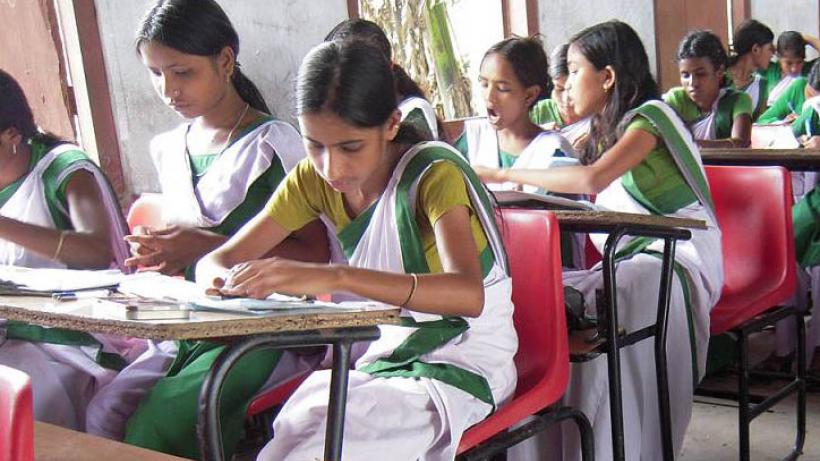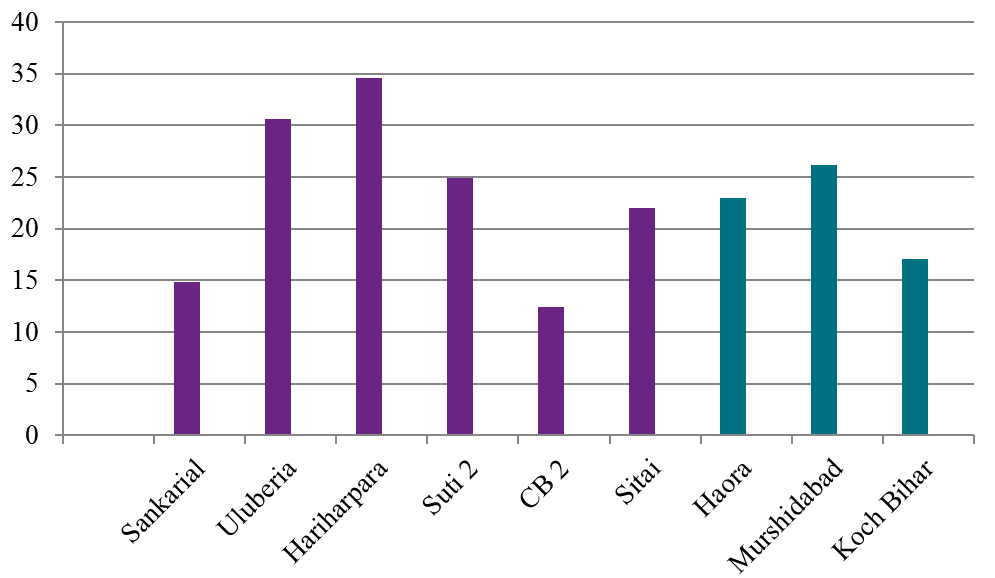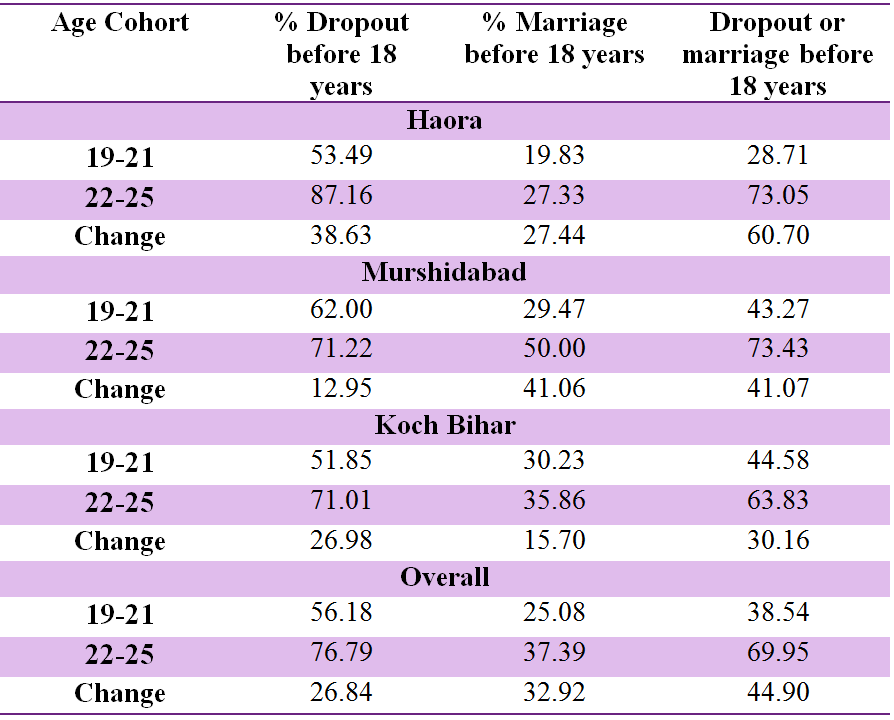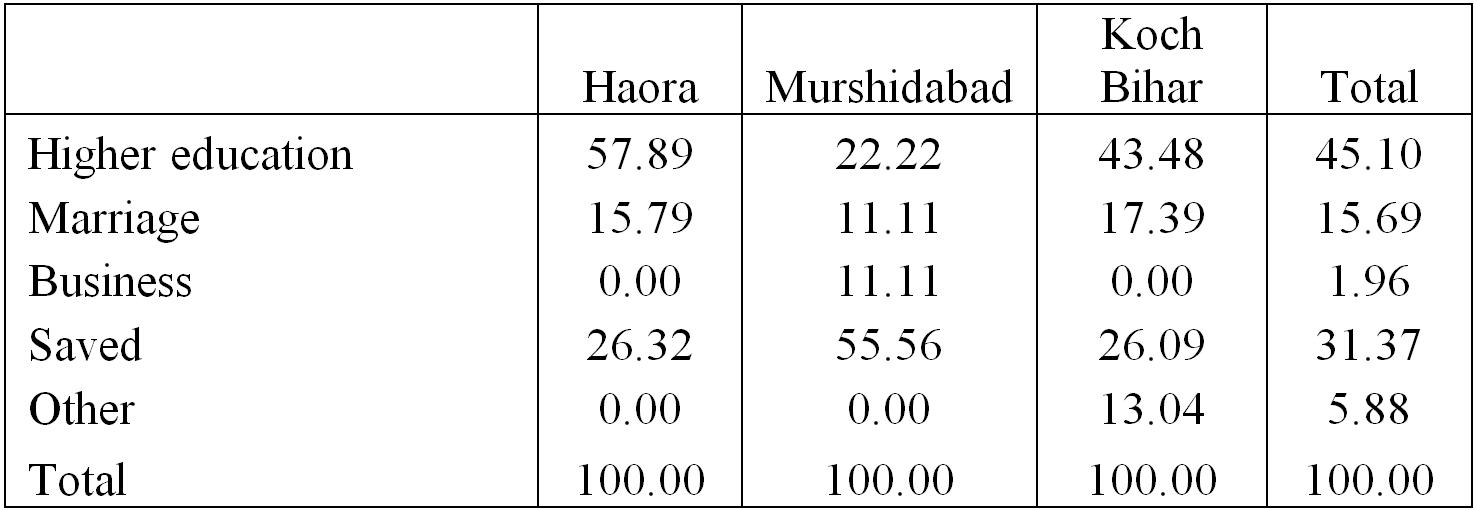
Reducing under-age marriage and school dropout in West Bengal
Under-age marriage and adolescent school dropout is a serious problem in India. It is most critical in West Bengal, an Eastern state of India, bordering Bangladesh. According to the 2011 Indian Government Census, West Bengal has the highest incidence of child marriage among girls (7.8%), much higher than the national average of 3.7%. It also has a low mean average of years in schooling for girls (again, far lower than national average). The ranking of the state has deteriorated sharply since 1990 in terms of both under-age marriage and adolescent school dropout.
The Kanyashree Prakalpa programme
Literature suggests that high shares of out-of-school girls coupled with early marriage have serious implications on their empowerment, health care and skill development (Schultz 2002). Most Conditional Cash Transfer (CCT) schemes directly benefit enrolment in primary education and retention in secondary education. The Kanyashree Prakalpa (KP) programme, introduced by the Government of West Bengal in 2012, is unique by having dual targets of reducing teenage marriage and completion of secondary education among females.
Two-phase scholarship scheme
KP offers a two-phase scholarship of Rs750 (Rs = Indian rupees. $1 is approximately 65 rupees) annually for continuing education (KP1 phase) for adolescent girls aged 13-17 years, and a one-time payment of Rs25,000 on completion of education at 18 years, conditional upon the girl remaining unmarried (KP2 phase). This scheme has the potential to increase skill development and awareness among adolescent girls, thus increasing female participation in the skilled job market. This would improve the bargaining power of the women and lower maternal and infant mortality.
Existing literature
School dropout
i) Household income
Analysis of secondary data indicates a strong income effect on the possibility of dropout for adolescent girls in West Bengal. Using bivariate probit regression on unit level data from the National Sample Survey Office (NSSO) 71st Round Education, Dutta and Ghosh (2016) finds monthly per capita expenditure (MPCE) of households to be a strong determinant of school dropout.
Early marriage
i) Household income
Although literature suggests that early marriage is strongly associated with poverty (Otoo-Oyortey and Pobi 2003), Sen and Modak (2017) observe that household wealth (taken as a proxy for household income) did not affect chances of early marriage in West Bengal. This negates the perception that poverty is the driving force behind child marriage and therefore that a cash transfer to the household would reduce child marriage.
ii) Literacy
Using logistic regression models on District Level Household Survey (DLHS) 4 unit data, collected from 2012-13, the above study finds that girls with secondary and higher education had much lower chances of early marriage compared to illiterate ones. Thus, education and early marriage are closely linked. The KP targets both these social evils together and transfers the money directly to the girls’ account. This slight twist in the conditions makes this scheme an interesting study.
The Study
In our study, we surveyed 1037 adolescent girls from 1020 households in three districts of West Bengal: Howrah, Koch Behar and Murshidabad.
The girls were divided into three age cohorts:
1) 14-18 years: girls currently in KP1 phase.
2) 19-21 years: women who have/could have availed the KP2 phase.
3) 22-25 years: women who older than 18 when the scheme started.
Findings
School dropout and marriage
Analysis of the data from complete house-listings of selected villages reveals that many girls between 14-18 years have either dropped out of school or got married or both. In Murshidabad, 26.17% of the girls have failed to adhere to the KP criteria (Figure 1). The proportion is quite high in Haora, too. Koch Bihar recorded the lowest rates of either getting married or dropping out of school (17.07%).
Figure 1: Proportion of adolescent girls of 14-17 years dropped out, married or both

Note: Purple bars: Blocks. Blue bars: Districts
Source: Analysis of individual survey data
Comparing the age cohorts 19-21 years and 22-25 years, we see that both drop out and early marriage has fallen among the age group covered by KP (Table 2). The table posits that the decline in dropout rates was most pronounced in Haora and the least in Murshidabad. Similarly, the change in under-age marriage is the highest in Murshidabad and the lowest in Koch Bihar. Murshidabad thus emerges as an interesting case study where people became more aware about the negative consequences of child marriage, but not about continuing education.
Table 2: Dropout and under-age marriage among two age cohorts

Source: Analysis of individual survey data
Attitudes
To determine whether the KP had any impact in changing the attitude of adolescent girls and their families towards education and early marriage, we studied whether a girl faced any pressure for early marriage or dropout and whether she successfully managed to resist it. Table 3 shows that the pressure for early marriage was less among girls in the age cohort 19 -21 than in 22-25 in all districts. It is also heartening to note that the proportion of girls who successfully resisted early marriage increased, and those who did not resist decreased.
While pressure for marriage has reduced in all districts, pressure for dropout has reduced in Haora, and increased slightly in Murshidabad and Koch Bihar (Table 4). The incidence of girls successfully resisting such pressure has increased in Koch Bihar. The proportion of women who did not put up any resistance to pressure for discontinuing education has decreased in all districts.
Table 3: Pressure and resistance towards early marriage

Source: Analysis of individual survey data
Table 4: Pressure and resistance towards adolescent dropout

Source: Analysis of individual survey data
Cash transfers and dowry
An area of concern regarding the cash transfer at eighteen was that this money would be utilised as dowry in marriage and the practice of dowry would be encouraged. We observed that an overwhelming majority used the KP1 money for educational purposes (Table 5). While 15.78% in Haora, 11.11% in Murshidabad, and 17.39% in Koch Bihar did use the KP2 money for marriage purposes, a far higher proportion used it for higher education (Table 6). In Murshidabad, where the prevalence of higher education among girls is low, 55.56% of the girls saved the money. Thus, while some of the girls did use the KP2 money for marriage, perhaps dowry, they do not form the majority and the money helps most of them in their higher studies, thus achieving the target of the scheme.
Table 5: Use of KP1 money

Source: Analysis of individual survey data
Table 6: Use of KP2 money

Source: Analysis of individual survey data
Conclusion
The findings suggest that in West Bengal, poverty is not the reason for early marriage, however it is one of the important factors for school dropout among adolescent girls. Moreover, education is one of the most important factors that prevent early marriage. In this way, a conditional cash transfer, which requires a girl to remain both unmarried and continuing her education until eighteen years of age, is justified.
The data collected from three districts in West Bengal, demonstrates that the incidence of child marriage and dropout before eighteen has fallen in all three districts between comparable age cohorts. The programme has also generated an awareness regarding the negative consequences of child marriage. This impact is most pronounced in the most backward district of West Bengal, Murshidabad.
Pressure from parents for early marriage and discontinuing education has reduced, and resistance from girls to pressure has increased. It has also been observed that most of the girls either use the money from the scheme for higher education or save it, instead of using it for marriage purposes, putting to rest the concern that this scheme would encourage the practice of dowry.
To ascertain a more precise understanding of the impact of the scheme, a detailed impact evaluation of the programme is called for and will be performed over the next couple of months.
References
2011 Census Data (2011), Population Enumeration Data, Office of the Registrar General & Census Commissioner, Ministry of Home Affairs, Government of India. Accessible: http://www.censusindia.gov.in/2011-Common/CensusData2011.html
The International Institute for Population Sciences (IIPS), Mumbai (Ongoing), District Level Household and Facility Survey (DLHS) 4, designated by the Ministry of Health and Family Welfare (MoHFW), Government of India. Accessible: http://rchiips.org/
Dutta, A and Ghosh (2016), Choice of schooling and incidence of adolescent dropouts: An empirical study across selected Indian states. Working paper, Department of Economics, University of Calcutta. Forthcoming.
Glick, P C (1957) American Families, New York: John Wiley and Sons, Incorporated, p. 154.
National Sample Survey Office (NSSO), Ministry of Statistics and Programme Implementation (MOSPI) (2014), 71st Round Education: Social Consumption on education. Government of India. Accessible: http://mail.mospi.gov.in/index.php/catalog/160
Otoo-Oyortey, N and Pobi, S (2003), “Early Marriage and Poverty: Exploring links and key policy issues”, Gender & Development, 11(2), pp.42-51.
Schultz, T P (2002), Why governments should invest more to educate girls. World Development, 30(2), pp.207-225.
Sen, A and Modak, P (2017), An analysis of the determinants of child marriage in West Bengal and the rest of India, Working paper, Department of Economics, University of Calcutta. Forthcoming.

